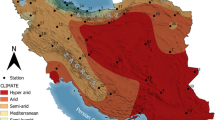Abstract
Four precipitation observational networks with varied station densities are maintained in China. They are: the Global Climate Observation System (GCOS) Surface Network (GSN), the national Reference Climate Network (RCN), the national Basic Meteorological Network (BMN), and the national Ordinary Meteorological Network (OMN). The GSN, RCN, BMN, and the merged network of RCN and BMN (R&B) have been widely used in climatology and climate change studies. In this paper, the impact of the usage of different networks on the precipitation climatology of China is evaluated by using the merged dataset of All Station Network (ASN) as a benchmark. The results show that all networks can capture the main features of the country average precipitation and its changing trends. The differences of average annual precipitation of the various networks from that of the ASN are less than 50 mm (⩽ 10%). All networks can successfully detect the rising trend of the average annual precipitation during 1961–2009, with the R&B exhibiting the best representativeness (only 2.90% relative difference) and the GSN the poorest (39.77%). As to the change trends of country average monthly precipitation, the networks can be ranked in descending order as R&B (1.27%), RCN (2.35%), BMN (4.17%), and GSN (7.46%), and larger relative differences appear from August to November. The networks produce quite consistent spatial patterns of annual precipitation change trends, and all show an increasing trend of precipitation in Northwest and Southeast China, and a decreasing trend in North China, Northeast China, and parts of central China. However, the representativeness of the BMN and R&B are better in annual and seasonal precipitation trends, in spite of the fact that they are still far from satisfactory. The relative differences of trends in some months and regions even reach more than 50%. The results also show that the representativeness of the RCN for country average precipitation is higher than that of the BMN because the RCN has a more homogeneous distribution of stations.
Similar content being viewed by others
References
DeGaetano, A. T., 2001: Spatial grouping of United States climate stations using a hybrid clustering approach. Int. J. Climatol., 21, 791–807.
Gandin, L. S., 1970: The Planning of Meteorological Station Networks. WMO Tech. Note. III.
Hu Ting, Zhou Jiangxing, and Dai Kan, 2012: Application of US station density strategy in China climate reference network. J. Appl. Meteor. Sci., 23(1), 40–46. (in Chinese)
Hubbard, K. G., 1994: Spatial variability of daily weather variables in the high plains of the USA. Agric. For. Meteorol., 68, 29–41.
Janis, M. J., K. G. Hubbard, and K. T. Redmond, 2002: Determining the optimal number of stations for the United States Climate Reference Network. US Southeast Regional Climate Center Research Paper Series.
—, —, and —, 2004: Station density strategy for monitoring long-term climatic change in the contiguous United States. J. Climate, 17, 151–162.
Jones, P. D., and A. Moberg, 2003: Hemispheric and large-scale surface air temperature variations: An extensive revision and an update to 2001. J. Climate, 16, 206–223.
Karl, T. R., H. F. Diaz, and G. Kukla, 1988: Urbanization: Its detection and effect in the United States climate record. J. Climate, 1, 1099–1123.
—, V. E. Derr, D. R. Easterling, et al., 1995: Critical issues for long-term climate monitoring. Climatic Change, 31, 185–221.
Ren Guoyu, Guo Jun, Xu Mingzhi, et al., 2005: Climate changes of mainland China over the past half century. Acta Meteor. Sinica, 63(6), 942–956. (in Chinese)
—, Zhou Yaqing, Chu Ziying, et al., 2008: Urbanization effect on observed surface air temperature trend in North China. J. Climate, 21(6), 1333–1348.
Ren Yuyu, Ren Guoyu, and Zhou Jiangxing, 2012: The ideal density and distribution of China climate network for monitoring surface climate change. J. Appl. Meteor. Sci., 23(2), 205–213. (in Chinese)
von Storch, H., and F. W. Zwiers, 1999: Statistical Analysis in Climate Research. Cambridge University Press, 484 pp.
Vose, R. S., and M. J. Menne, 2004: A method to determine station density requirements for climate observing network. J. Climate, 17(15), 2961–2971.
Zhang Aiying, Ren Guoyu, and Zhou Jiangxing, 2010: Urbanization effect on surface air temperature trends over China. Acta Meteor. Sinica, 68(6), 957–966. (in Chinese)
Zhang Renhe and Xu Xiangde, 2008: Climatic Observation System of China. China Meteorological Press, 291 pp. (in Chinese)
Zhao Ruixia, Li Wei, Wang Yubin, et al., 2007: The application of spatial structure functions to the design of weather station networks in Beijing area. J. Appl. Meteor. Sci., 18(1), 94–101. (in Chinese)
Zhou, L. M., R. E. Dickinson, Y. H. Tian, et al., 2004: Evidence for a significant urbanization effect on climate in China. Proc. Natl. Acad. Sci. USA, 101, 9540–9544.
Author information
Authors and Affiliations
Corresponding author
Additional information
Supported by the China Meteorological Administration (CMA) Special Public Welfare Research Fund (GYHY201206012), National Basic Research and Development (973) Program of China (2010CB428401), and CMA Climate Change Project (CCSF2010-9).
Rights and permissions
About this article
Cite this article
Ren, Y., Ren, G. Representativeness of four precipitation observational networks of China. Acta Meteorol Sin 26, 454–466 (2012). https://doi.org/10.1007/s13351-012-0405-8
Received:
Accepted:
Published:
Issue Date:
DOI: https://doi.org/10.1007/s13351-012-0405-8




